In modern machinery, reliability often depends on the smallest components.
Bushings, also called bearing sleeves or liners, are one such part. They reduce friction between moving parts and protect shafts or housings from wear.
When high loads, abrasive fluids, or extreme temperatures are involved, standard steel bushings wear out quickly. That’s where tungsten carbide bushings come in.
These bushings are made from one of the hardest engineering materials available — tungsten carbide (WC) — which provides exceptional résistance à l'usure, dureté, and corrosion protection.
This article explains what bagues en carbure de tungstène are, how they work, where they are used, and why they are a smart investment for demanding industries.
What Is a Tungsten Carbide Bushing?
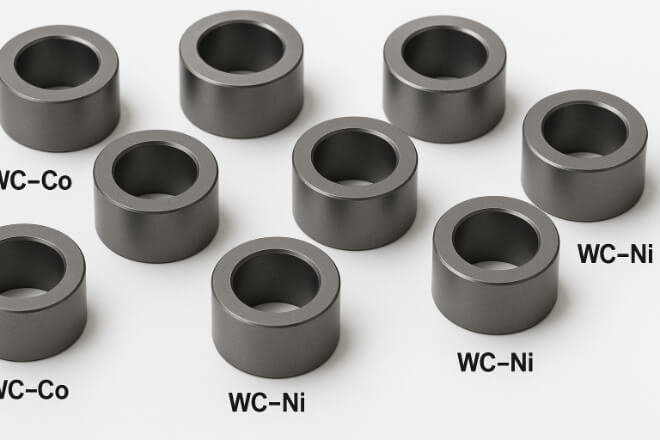
UN tungsten carbide bushing is a precision-machined sleeve made from poudre de carbure de tungstène bonded with cobalt or nickel.
It is designed to support and guide rotating or sliding shafts in pumps, compressors, turbines, and vannes.
Unlike standard steel or bronze bushings, carbide bushings maintain their shape and dimensions under high pressure, high speed, and abrasive conditions.
Their high dureté (around 90 HRA) allows them to last much longer than other materials.
How Tungsten Carbide Bushings Work
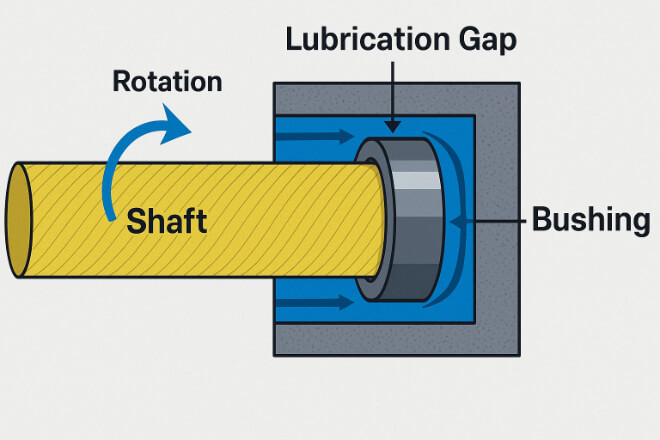
Tungsten carbide bushings function as protective liners or bearing surfaces inside mechanical systems. Their main role is to:
Reduce friction between rotating parts
Absorb radial loads
Prevent shaft wear or misalignment
Provide stable support even in dirty or abrasive environments
A thin film of lubricant (oil, water, or gas) separates the shaft and the bushing, minimizing metal-to-metal contact.
The smooth inner bore of the bushing allows the shaft to rotate with minimal energy loss and maximum durability.
Key Properties of Tungsten Carbide Bushings
| Propriété | Valeur typique | Importance |
|---|---|---|
| Dureté | 88–92 HRA | Resists wear and deformation |
| Densité | 14.0–15.0 g/cm³ | Provides high strength and impact resistance |
| Résistance à la compression | > 4000 MPa | Handles heavy loads and pressure |
| Conductivité thermique | 80–100 W/m·K | Efficient heat dissipation during operation |
| Résistance à la corrosion | Excellent in water, oil, and mild chemicals | Ideal for harsh environments |
These properties make tungsten carbide bushings especially suitable for high-speed, abrasive, and corrosive applications where reliability is essential.
Common Grades of Tungsten Carbide Bushings
Different grades of tungsten carbide are selected based on the binder type, grain size, and working environment.
| Type de note | Liant | Applications |
|---|---|---|
| WC–Co | Cobalt (6–12%) | General wear and mechanical loads |
| WC–Ni | Nickel (6–10%) | Corrosive and chemical environments |
| Fine-Grain WC | Cobalt (≤6%) | High-precision and high-speed applications |
Nickel-bonded grades are preferred in corrosive chemical or seawater environments, while cobalt-bonded grades are commonly used in oilfield and mechanical wear applications.
Applications of Tungsten Carbide Bushings
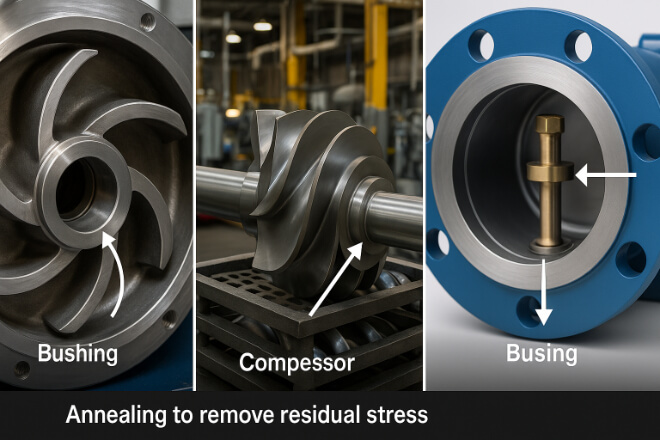
Tungsten carbide bushings are used across industries where long service life, precision, and résistance à l'usure ou résistance à la corrosion are critical.
Common Applications
Pumps: For shaft sleeves, impeller liners, and bearing supports.
Compressors: For dynamic sealing and high-speed rotation.
Submersible motors: To handle abrasive water with sand or silt.
Valves and actuators: To prevent metal-to-metal wear in critical assemblies.
Pétrole et gaz drilling tools: For stabilizers and mud pump liners.
Chemical process systems: To resist corrosion from acids and solvents.
Advantages Over Steel or Bronze Bushings
| Fonctionnalité | Bague en carbure de tungstène | Steel / Bronze Bushing |
|---|---|---|
| Dureté | Extremely high (90 HRA) | Moderate (60–70 HRA) |
| Résistance à l'usure | Outstanding in abrasive media | Poor under abrasive load |
| Résistance à la corrosion | Excellent (especially Ni-binder) | Limited (requires coatings) |
| Durée de vie | 5–10× longer | Shorter under load |
| Operating Cost | Higher initial cost, lower lifecycle cost | Cheaper upfront, frequent replacement |
For companies managing high-wear or corrosive systems, switching to tungsten carbide bushings means lower downtime and fewer replacements — directly improving total cost of ownership.
Design and Manufacturing Considerations
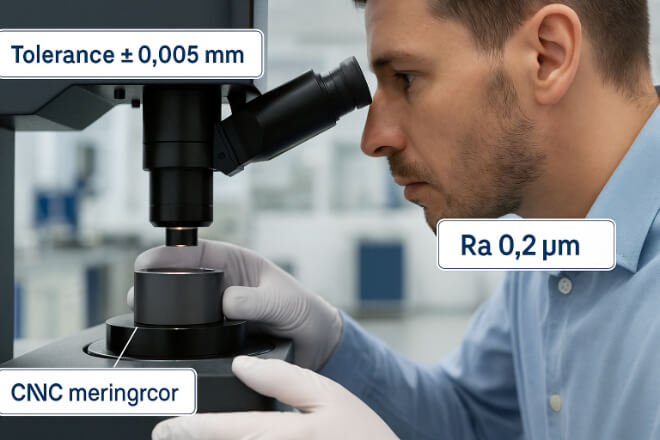
Designing and producing a tungsten carbide bushing requires tight process control:
Tolérance dimensionnelle: ±0.005 mm
Surface finish: Ra ≤ 0.2 µm for rotating surfaces
Chamfered edges: Prevent cracking during installation
Lubrication grooves: Custom patterns for oil or water lubrication
Nickel or cobalt binder selection: Based on corrosion risk
Each ring is sintered, machined with diamond tools, and often polished to near mirror finish to reduce friction and enhance longevity.
Maintenance and Handling Tips
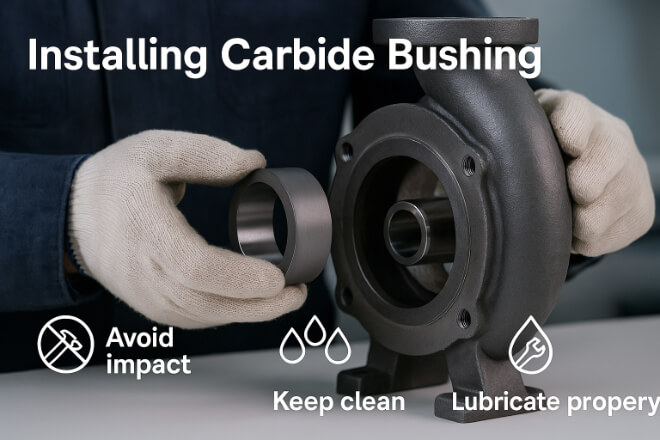
Although carbide bushings are durable, proper handling extends their service life:
Avoid impact or dropping — carbide is hard but brittle.
Clean before assembly to remove particles that could scratch the surface.
Use compatible lubricants or seal fluids to prevent dry operation.
Inspect regularly for signs of wear, scoring, or misalignment.
Cost and Return on Investment (ROI)
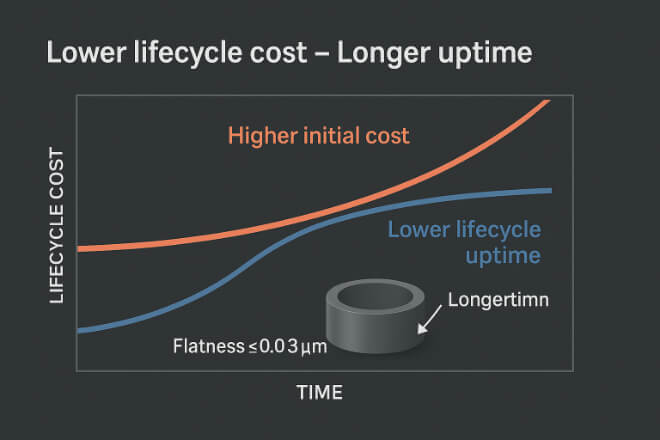
While tungsten carbide bushings cost more upfront, they last significantly longer and perform better in severe conditions.
In applications such as slurry pumps or seawater compressors, their extended lifespan and reduced downtime lead to ROI within 6–12 months.
Conclusion
Tungsten carbide bushings are the backbone of modern industrial sealing and bearing systems.
Their unmatched dureté, résistance à l'usure, and stability under pressure make them essential for pumps, compressors, and chemical equipment that must run continuously and reliably.
For decision-makers, choosing carbide bushings means fewer replacements, greater uptime, and lower lifecycle costs — all while ensuring safe, efficient performance in harsh environments.
Si vous souhaitez en savoir plus sur une entreprise, n'hésitez pas à Contactez-nous.
